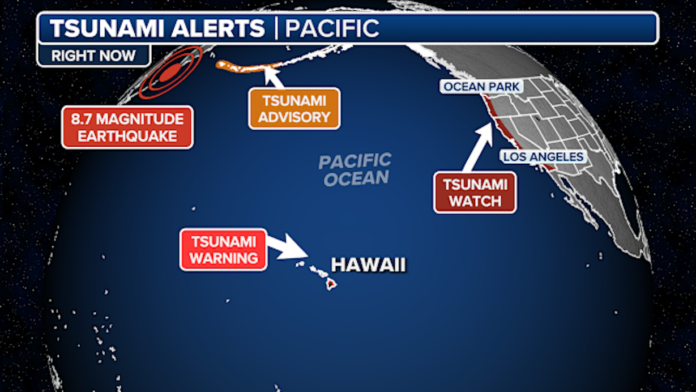- Hawaii and the entire U.S. West Coast are under tsunami alerts after a massive 8.8 magnitude earthquake struck near Russia’s Kamchatka Peninsula.
- Hawaiians evacuated coastal areas, with sirens blaring and traffic jamming highways as waves over 10 feet were expected to hit overnight.
- California, Oregon, and Washington issued tsunami advisories, warning of dangerous waves and strong currents along beaches and harbors.
Millions of Americans were put on high alert late Tuesday night after a colossal 8.8 magnitude earthquake near Russia triggered tsunami warnings that stretched from Hawaii to the entire U.S. West Coast.
As news of the undersea quake—one of the largest in over a decade—broke, sirens and alerts began sounding across the Pacific. The U.S. scrambled into action, with emergency services warning coastal communities from California to Washington State to brace for incoming waves that could arrive within hours.
Here’s how the tsunami threat unfolded across America—and which areas are most at risk.
Hawaii: Sirens Wail as Evacuations Begin
The most immediate threat loomed over Hawaii. Tsunami sirens blared across the islands just minutes after the quake struck off Russia’s Kamchatka Peninsula around 7:24 p.m. EST.
On Oahu, panic set in quickly. Emergency officials from the Department of Emergency Management urged residents in low-lying areas to evacuate immediately or head for higher ground. Traffic clogged highways in Honolulu as families rushed inland. Supermarkets saw a surge of last-minute shoppers grabbing water, canned goods, and flashlights.
Military installations opened access routes like Kolekole Pass and sections of Schofield Barracks to assist evacuations. The Pacific Tsunami Warning Center warned waves could reach over 10 feet above normal tide levels in some areas of the Northwestern Hawaiian Islands.
“This tsunami could be destructive,” authorities cautioned. “Stay away from all coastal areas until the all-clear is given.”
California: West Coast Braces for Early Morning Waves
From San Diego to Crescent City, California’s entire coast fell under a tsunami advisory. Emergency services didn’t issue evacuation orders but urged coastal residents to stay out of the water and off the beaches.
According to forecasters, tsunami waves were expected to begin hitting California’s shoreline around 3 a.m. EST (midnight local time). While not as high as those projected for Hawaii, even smaller tsunami waves can pose serious risks, especially in harbors, marinas, and inlets where wave energy gets funneled and intensified.
The National Weather Service warned that coastal flooding, strong currents, and unpredictable surges could make beaches and piers extremely dangerous.
“If you’re near the water, move inland or to higher ground now,” read one alert from NWS Los Angeles. “Do not return until officials say it’s safe.”
Oregon and Washington: Coastal Communities on Edge
Further north, Oregon and Washington State were also placed under tsunami advisories. Though the expected wave height wasn’t immediately alarming—projected to be under three feet in most places—emergency management officials stressed that even modest waves could cause property damage, injuries, or drownings.
In coastal towns like Seaside, Newport, and Long Beach, local emergency crews patrolled beaches, posted signs, and warned late-night beachgoers to stay far away from the shore.
Schools in some coastal districts were placed on alert for possible schedule changes or closures if conditions worsened overnight.
Meteorologists emphasized the unpredictable nature of tsunami waves: “It’s not just one wave and done. Dangerous currents can last for hours.”
Alaska: Heightened Alert, But Minimal Risk
While Alaska was not under an official tsunami warning, it remained under close observation. The state’s southern coastline has seen tsunami impacts in the past from distant earthquakes, and officials in cities like Kodiak and Anchorage advised residents to stay tuned for updates through Wednesday morning.
Public Reaction: Confusion, Concern, and a Race Against Time
Social media lit up with messages from coastal residents wondering whether they should evacuate. Many expressed frustration at what they called vague or delayed information from authorities. Others shared stories of rushing to gas stations, trying to fill up tanks in case they needed to leave quickly.
“I live in Ventura, and I didn’t know what to do. The alert said ‘advisory,’ but should I evacuate?” wrote one user on X (formerly Twitter).
Meteorologist Matthew Cappucci added his voice to the chorus of urgency: “If you’re in a tsunami advisory area, take it seriously. Move away from beaches, harbors, and marinas. If you’re on a boat and can’t dock, head out to deeper water where the wave energy spreads out.”
What Is a Tsunami Advisory?
Unlike a tsunami warning, which signals that destructive waves are imminent and evacuation is necessary, a tsunami advisory indicates that waves capable of causing strong currents and flooding are likely—but not necessarily life-threatening if precautions are taken.
Still, officials made it clear: an advisory is not a green light to watch the waves roll in. In fact, spectators often become casualties during tsunamis.
The National Weather Service was blunt in its wording: “Stay off the beach. Stay out of the water. Stay safe.”




